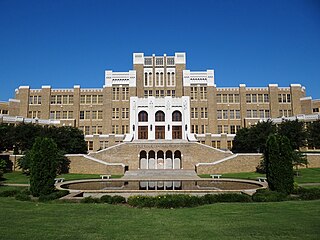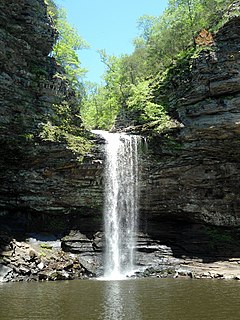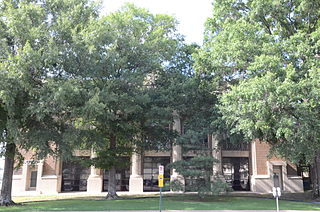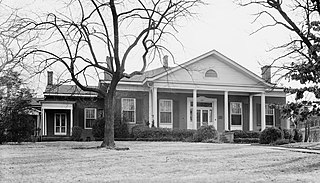
Little Rock Central High School (LRCHS) is an accredited comprehensive public high school in Little Rock, Arkansas, United States. The school was the site of forced desegregation in 1957 after the U.S. Supreme Court ruled that segregation by race in public schools was unconstitutional three years earlier. This was during the period of heightened activism in the civil rights movement.

Petit Jean State Park is a 3,471-acre (1,405 ha) park in Conway County, Arkansas managed by the Arkansas Department of Parks and Tourism. It is located atop Petit Jean Mountain adjacent to the Arkansas River in the area between the Ouachita Mountains and Ozark Plateaus.

The Tower Building of the Little Rock Arsenal, also known as the Main Building of the U.S. Arsenal at Little Rock, or Headquarters Building of the Little Rock Barracks, is the home of the MacArthur Museum of Arkansas Military History. It is also a part of the MacArthur Park Historic District, in Little Rock, Arkansas.

Philander Smith College is a private historically black college, in Little Rock, Arkansas. Philander Smith College is affiliated with the United Methodist Church and is a founding member of the United Negro College Fund (UNCF). Philander Smith College is accredited by the North Central Association of Colleges and Schools.

Hillcrest Historic District is an historic neighborhood in Little Rock, Arkansas that was listed on the National Register of Historic Places on December 18, 1990. It is often referred to as Hillcrest by the people who live there, although the district's boundaries actually encompass several neighborhood additions that were once part of the incorporated town of Pulaski Heights. The town of Pulaski Heights was annexed to the city of Little Rock in 1916. The Hillcrest Residents Association uses the tagline "Heart of Little Rock" because the area is located almost directly in the center of the city and was the first street car suburb in Little Rock and among the first of neighborhoods in Arkansas.

The Dallas County Courthouse, built in 1892 of red sandstone with rusticated marble accents, is a historic governmental building located at 100 South Houston Street in Dallas, Texas. Also known as the Old Red Courthouse, it became the Old Red Museum, a local history museum, in 2007. It was designed in the Richardsonian Romanesque style of architecture by architect Max A. Orlopp, Jr. of the Little Rock, Arkansas based firm Orlopp & Kusener. In 1966 it was replaced by a newer courthouse building nearby. On December 12, 1976, it was added to the National Register of Historic Places. In 2005–2007 the building was renovated.
The University of Arkansas Campus Historic District is a historic district that was listed on the National Register of Historic Places on September 23, 2009. The district covers the historic core of the University of Arkansas campus, including 25 buildings.

Charles L. Thompson and associates is an architectural group that was established in Arkansas since the late 1800s. It is now known as Cromwell Architects Engineers, Inc.. This article is about Thompson and associates' work as part of one architectural group, and its predecessor and descendant firms, including under names Charles L. Thompson,Thompson & Harding,Sanders & Ginocchio, and Thompson, Sanders and Ginocchio.

The Robinson Center is a performance, convention, and exhibition space at Statehouse Plaza in downtown Little Rock, Arkansas.

The Gazette Building in downtown Little Rock, Arkansas was built in 1908. It was designed by architect George R. Mann, and built by Peter Hotze. The building was listed on the U.S. National Register of Historic Places in 1976. Originally and for many years, the building served as the headquarters of the Arkansas Gazette newspaper. After the Gazette was sold and became the Arkansas Democrat-Gazette, the building served as the national campaign headquarters for the 1992 presidential campaign of Governor Bill Clinton. It now houses the Elementary and Middle Schools for eStem Public Charter Schools.

Curran Hall, also known as the Walters-Curran-Bell House, is a historic house at 615 East Capitol Street in Little Rock, Arkansas. It was built in 1842 for Colonel Ebenezer Walters. The single story house is built in the Greek Revival style with Doric pilasters at the entrance way. Two auxiliary buildings, constructed at about the same time as the main building, were moved and attached to the rear of the house in 1891.

The former National Guard Armory of Batesville, Arkansas, is located at 380 South Ninth Street. Built in 1936, it is a large and imposing sandstone structure with Gothic Revival and Art Deco features.

The Old Little Rock Central Fire Station is a historic firehouse, next to Little Rock City Hall at 520 West Markham Street in downtown Little Rock, Arkansas. It is, from its front, a Beaux Arts two-story masonry building, designed by Charles L. Thompson and built in 1913. The front facade is dominated by the former equipment bays, which are separated by fluted columns, and topped by an elaborate architrave. The building is now used for other purposes by the city.

Little Rock City Hall, the seat of municipal government of the city of Little Rock, Arkansas, is located at 500 West Markham Street, in the city's downtown. It is a Renaissance Revival structure, designed by Arkansas architect Charles L. Thompson and built in 1907. Its main facade has a projecting Roman portico, supported by fluted Ionic columns, with flanking sections that have Roman-style round-arch openings. The building housed most of the city's departments until the 1950s.

The Memorial to Company A, Capitol Guards was an American Civil War memorial in MacArthur Park, Little Rock, Arkansas. It stood just northeast of the former Tower Building of the Little Rock Arsenal, at a junction of two of the park's internal roadways. It consisted of a bronze sculpture depicting a Confederate Army soldier in a defensive stance, holding a rifle pointed forward. The statue was 8 feet (2.4 m) in height, and was mounted in a granite column 16 feet (4.9 m) tall. The memorial was sometimes known as "Lest we forget", a line that appeared near the top of the inscription on the base. The statue was created by sculptor Rudolph Schwarz, and was installed in 1911; it was paid for by the local chapter of the Sons of Confederate Veterans, and memorializes the unit that seized the arsenal at the outset of the war.

North Little Rock City Hall is located at 300 Main Street in North Little Rock, Arkansas. It is a Classical Revival two-story building, with an exterior of stone with terra cotta trim. Prominent features of its street-facing facades are massive engaged two-story fluted Ionic columns. It was built in 1914–15, and is based on the design of a bank building seen by Mayor J.P. Faucette in St. Louis, Missouri.

St. Joseph's Home is a historic Roman Catholic orphanage on Camp Robinson Road in North Little Rock, Arkansas. It is a large three-story brick building, with a tile hip roof and a stone foundation. The roof is topped by a cupola with a cross as a spire. The building is roughly H-shaped, with projecting wings on either side of central section. It has eighty bedrooms. It was built in 1910 by the Roman Catholic Diocese of Little Rock.

The South Main Street Apartments Historic District encompasses a pair of identical Colonial Revival apartment houses at 2209 and 2213 Main Street in Little Rock, Arkansas. Both are two-story four-unit buildings, finished in a brick veneer and topped by a dormered hip roof. They were built in 1941, and are among the first buildings in the city to be built with funding assistance from the Federal Housing Administration. They were designed by the Little Rock firm of Bruggeman, Swaim & Allen.

Originally known as Taborian Temple, the building was constructed in 1916 by the Arkansas chapter of the Knights and Daughters of Tabor when the 9th street area of Little Rock, Arkansas was a major hub of African-American commerce.

Trapnall Hall is a historic house at 423 East Capitol Avenue in downtown Little Rock, Arkansas. Built in 1843 for lawyer Frederic Trapnall; one of Arkansas's finest examples of pre-Civil War Greek Revival architecture. It is a single-story brick building, with a hip roof and a projecting temple portico supported by square columns. The building is now owned by the state, which uses it as an venue for public and private events.




















